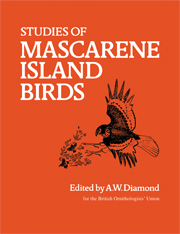Book contents
- Frontmatter
- Contents
- List of contributors
- Foreword
- Introduction
- I The native avifauna of the Mascarene Islands
- 1 An ecological history of the Mascarene Islands, with particular reference to extinctions and introductions of land vertebrates
- 2 The fossil record
- 3 Vocalisations of the endemic land-birds of the Mascarene Islands
- II The surviving native birds of Mauritius
- 4 The ecology of the smaller land-birds of Mauritius
- 5 The larger land-birds of Mauritius
- III The surviving native birds of Réunion and Rodrigues
- 6 The ecology of the surviving native land-birds of Réunion
- 7 Notes on the nesting of Procellariif ormes in Réunion
- 8 Observations on the surviving endemic birds of Rodrigues
- IV Measurements and weights
- 9 Measurements and weights of the surviving endemic birds of the Mascarenes and their eggs
- References
- Index
8 - Observations on the surviving endemic birds of Rodrigues
Published online by Cambridge University Press: 04 August 2010
- Frontmatter
- Contents
- List of contributors
- Foreword
- Introduction
- I The native avifauna of the Mascarene Islands
- 1 An ecological history of the Mascarene Islands, with particular reference to extinctions and introductions of land vertebrates
- 2 The fossil record
- 3 Vocalisations of the endemic land-birds of the Mascarene Islands
- II The surviving native birds of Mauritius
- 4 The ecology of the smaller land-birds of Mauritius
- 5 The larger land-birds of Mauritius
- III The surviving native birds of Réunion and Rodrigues
- 6 The ecology of the surviving native land-birds of Réunion
- 7 Notes on the nesting of Procellariif ormes in Réunion
- 8 Observations on the surviving endemic birds of Rodrigues
- IV Measurements and weights
- 9 Measurements and weights of the surviving endemic birds of the Mascarenes and their eggs
- References
- Index
Summary
Introduction
Rodrigues is the smallest and most ecologically devastated of the Mascarenes, retaining only three species of endemic land vertebrates from the wealth and diversity that existed there when the island was first discovered (North-Coombes 1980a, Chapter 1). The survivors are two birds, a warbler and a fody Foudia, considered here, and a flying-fox Pteropus rodricensis (Cheke & Dahl 1981). The ecological history of the island is reviewed in Chapter 1.
As the status of the Rodrigues Warbler Acrocephalus (Bebrornis) rodericanus was giving rise to “Very grave anxiety” with three-star rating in the Red Data Book (Vincent 1966), I lost no time in visiting Rodrigues after establishing the BOU Expedition's base in Mauritius. Since the distribution of my original report (Cheke 1974a) on the status of the endemic vertebrates, Rodrigues has been the focus of more biological and conservation interest than at any time since the famous Transit of Venus expedition of 1874 (Hooker & Günther 1879). Flying-foxes (Durrell 1977a, b) and Fodies (Cheke 1979a) have been captured for captive breeding, and all the species have been the subject of some further study (Cheke 1979a, 1980, Mungroo 1979, Carroll 1982a, b; C. G. Jones unpubl.). Particular recommendations for conservation of the vertebrates are to be found in a variety of reports already produced (Cheke 1974a, 1978a, b, 1980, Carroll 1982b, Jones & Owadally 1982a). This chapter discusses the general biology of the two birds.
I visited Rodrigues four times in 1974: 16-20 January, 25 February-13 March, 12-18 July and 12-15 December. Dr A. W. Diamond (AWD) and A. S. Gardner (ASG), visiting 4-15 February and 18-24 September 1975 respectively, have very kindly allowed me to use their observations.
- Type
- Chapter
- Information
- Studies of Mascarene Island Birds , pp. 364 - 402Publisher: Cambridge University PressPrint publication year: 1987
- 6
- Cited by



